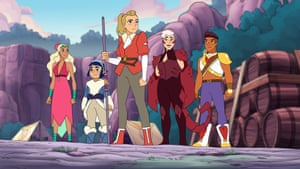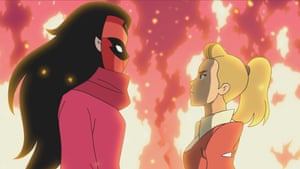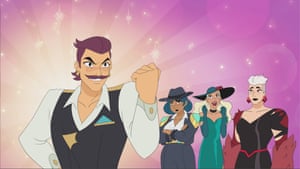She-Ra and the Princesses of Power: gripping not-just-for-kids cartoon that openly centres queer love
(ALWAYS SUSPECTED THAT SHE WAS THE PAL OF GAY HUNK HE-MAN)
Ostensibly a children’s show, She-Ra is a fantastical, nuanced treatment of good and evil that feels oddly relatable in these times
_(ef04def6065c81ceb7d81c967f1e2095c2d32a4d).png?width=300&quality=85&auto=format&fit=max&s=e9b9293758a22d40baaefc91e2ea77e9)
Megan Maurice
Thu 28 May 2020

She-Ra and the Princesses of Power is quite joyful to watch with a small child. Photograph: Netflix
“We’ve gotta find every bit of strength that we have and never let it go,” urges the theme song of She-Ra and the Princesses of Power, as it draws you into its warm embrace.
It feels relatable in these times. Sure, the reason I need “every bit of strength” is to figure out how to work from home while parenting a small child rather than to save the universe from unspeakable evil, but it’s comparable.
It’s one of many ways that She-Ra is perfect lockdown viewing. A reimagining of the 1980s spin-off of He-Man and the Masters of the Universe, the reboot delivers colourful escapism that’s gripping and plot-driven while also leaving you with the sense that you’d dive right in and fight alongside the rebellion if given the chance.
Riverdale: a campy, maximalist romp that leans into its own post-comic book absurdity
Read more
I originally tuned in when it began in 2018 because it looked like something my then four-year-old daughter might be interested in. By the time I discovered it was a few more steps towards terrifying than Bluey or Doc McStuffins, it had become essential family viewing.
The show centres around teenage soldier Adora, who was adopted into the Horde as a baby and has spent her life in the Fright Zone training to fight to wrest control of Etheria from the evil princesses that rule the planet. Just as she is preparing to embark on her first real mission, she stumbles across a mysterious sword and meets Glimmer and Bow, enemies of the Horde.
“We’ve gotta find every bit of strength that we have and never let it go,” urges the theme song of She-Ra and the Princesses of Power, as it draws you into its warm embrace.
It feels relatable in these times. Sure, the reason I need “every bit of strength” is to figure out how to work from home while parenting a small child rather than to save the universe from unspeakable evil, but it’s comparable.
It’s one of many ways that She-Ra is perfect lockdown viewing. A reimagining of the 1980s spin-off of He-Man and the Masters of the Universe, the reboot delivers colourful escapism that’s gripping and plot-driven while also leaving you with the sense that you’d dive right in and fight alongside the rebellion if given the chance.
Riverdale: a campy, maximalist romp that leans into its own post-comic book absurdity
Read more
I originally tuned in when it began in 2018 because it looked like something my then four-year-old daughter might be interested in. By the time I discovered it was a few more steps towards terrifying than Bluey or Doc McStuffins, it had become essential family viewing.
The show centres around teenage soldier Adora, who was adopted into the Horde as a baby and has spent her life in the Fright Zone training to fight to wrest control of Etheria from the evil princesses that rule the planet. Just as she is preparing to embark on her first real mission, she stumbles across a mysterious sword and meets Glimmer and Bow, enemies of the Horde.

Shadow Weaver and Adora: ‘good’ and ‘bad’ characters in She-Ra are equally humanised. Photograph: Netflix
In a moment reminiscent of Mitchell and Webb’s “Are We the Baddies?” sketch, Adora suddenly realises she has been fighting on the side of evil and the people she considers family are terrorising Etheria. Her connection to the sword becomes clear as she realises she can transform into She-Ra, a mythical princess with superhuman powers.
For all of its excitement and action, what I like best is the way it blurs the line between good and evil in a way that’s incredibly nuanced for what is ostensibly a children’s show. From Adora’s childhood best friend Catra, to the hug-loving butch Scorpia and even second-in-command Shadow Weaver who at first appears to be the epitome of an irredeemable villain, the members of the Horde are humanised and have as much depth to their characters as those in the rebellion.
This depiction of the characters as complex people with varying amounts of light and shade makes the relationships, illustrated against a background of a war zone, come to life. While elemental princess Mermista and the flamboyant sea captain Seahawk provide much of the comic relief with their unlikely romance, it’s the way She-Ra openly centres queer love and romance that’s really powerful.

Seahawk, Mermista, Perfuma and Scorpia. Photograph: Netflix
From married princesses Netossa and Spinnerella, to Rebellion archer Bow’s two dads, showrunner Noelle Stevenson put her cards on the table early in the series and continued to develop queer relationships that become more and more central to the plot as the series progresses.
It’s something that is quite joyful to watch with a small child. After years of seeing Disney princesses marry copy-and-paste princes, being able to see my daughter connecting with all these diverse relationships has been wonderful.
At the heart of the show is the relationship between Adora and Catra – fighting on opposite sides, they are at war for much of the show but through a series of flashbacks we see the depth of their connection as children and understand what they mean to each other. It’s a complicated relationship that’s tied up in friendship, hate, jealousy, power and love.
While the backdrop might not be of this world, the characters are as familiar as old friends, and finding every bit of strength that you have and never letting go is something we can all relate to, whether we’re fighting for our lives or just hoping to one day go back outside.
• She-Ra and the Princesses of Power, a Netflix Original, is streaming on Netflix
No comments:
Post a Comment